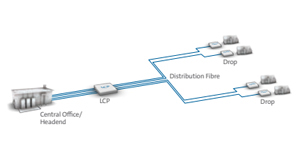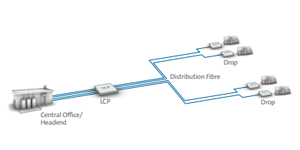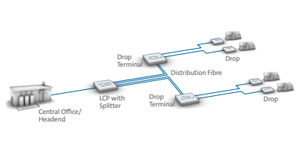Whether you are deploying RFoG, GPON, EPON, or looking forward to next-generation PON technologies, all can be accomplished with either a home run, centralized split, or distributed split architecture. With all, you should consider factors such as distance from the central office, future upgradability, OLT port efficiency, and total cost of ownership. Here you can see what these networks look like and what types of products are typically found in each.
What Type of FTTH Network Do I Need?
What Type of FTTH Network Do I Need?
Point-to-Point/Direct Drop
Point-to-Point/Direct Drop
- Typically deployed to subscribers within five miles of central office in conjunction with centralised split and distributed split architectures
- Home run architectures offer dedicated fiber from CO/HE to each subscriber with no splitters in the field, resulting in the most fiber-rich network architecture

Distributed Split
Distributed Split
- Gaining popularity in the United States based on widespread success in Latin America and Europe
- By distributing or cascading splits in two or more field locations, the physical size of products in the field can shrink in size as the ports at each location are shared until the last access point. This is the most fiber-lean network architecture shown

Centralised Split
Centralised Split
- Most common architecture deployed in the United States and Canada
- A single, centralised location for housing splitters in the field optimises OLT ports while leaning out the feeder network

FTTH Network Architectures Overview
| Point-to-Point/Direct Drop | Centralised Split | Distributed Split | |
 |
 |
 |
|
| Consolidated Point for Cable and Splicing Management | Yes | Yes | Yes |
| Cabinets in the Field | Yes, as aggregation point | Yes | Yes |
| Upfront Network CapEx | High | Moderate | Low |
| Fiber Density in Feeder/Distribution | Rich feeder and distribution cables | Lean feeder and rich distribution cables | Lean feeder and distribution cables |
| OLT Ports Efficiency | Best | Best | Fair to poor |
| Supports Efficient Growth Strategy | High | High | Low to medium |
| Split Ratios Flexibility | High | High | Low to medium |
| Easily Adaptable | Best | Best | Fair to poor |
| Quick Facts | • Typically deployed to subscribers within five miles of central office in conjunction with centralised split and distributed split architectures • Home run architectures offer dedicated fiber from CO/HE to each subscriber with no splitters in the field, resulting in the most fiber-rich network architecture |
• Most common architecture deployed in the United States and Canada • A single, centralised location for housing splitters in the field optimises OLT ports while leaning out the feeder network |
• Gaining popularity in the United States based on widespread success in Latin America and Europe • By distributing or cascading splits in two or more field locations, the physical size of products in the field can shrink in size as the ports at each location are shared until the last access point. This is the most fiber-lean network architecture shown |

Ready to Evaluate Your Options?
Ready to Evaluate Your Options?
It’s time to design and plan for the installation. Learn what factors impact your design decisions, how you can manage your project, and why we have the experience to guide you through the process.
It’s time to design and plan for the installation. Learn what factors impact your design decisions, how you can manage your project, and why we have the experience to guide you through the process.
Learn MoreTools & Resources
Products
Products
Explore our expansive product selection to find the right solution for your needs.
Explore our expansive product selection to find the right solution for your needs.
Learn MoreLoyalty Programs
Loyalty Programs
Learn about our variety of loyalty programs and how they can best benefit you.
Learn about our variety of loyalty programs and how they can best benefit you.
Learn MoreContact Us
Contact Us
In need of assistance? Reach out to one of our experienced customer care professionals.
In need of assistance? Reach out to one of our experienced customer care professionals.
Contact UsWhere to Buy
Where to Buy (Find Your Distributor)
Corning works in close cooperation with a wide range of qualified intermediaries including installers, distributors and network design planners throughout EMEA. Our distributors have robust programs for end users, contractors and installers and are ready to support your needs.
Corning works in close cooperation with a wide range of qualified intermediaries including installers, distributors and network design planners throughout EMEA. Our distributors have robust programs for end users, contractors and installers and are ready to support your needs.
Learn MoreResource Library
Resource Library
Your online resource library gives you all the technical information you need, from product specifications to application examples, solution overviews and installation tutorials, all in one easy, central location at your fingertips.
Your online resource library gives you all the technical information you need, from product specifications to application examples, solution overviews and installation tutorials, all in one easy, central location at your fingertips.
Learn MoreBOM Tool
BOM Tool
Creating a bill of materials? Let us help you speed up the process with our Enterprise BOM tools.
Creating a bill of materials? Let us help you speed up the process with our Enterprise BOM tools.
Learn MoreCertificate Center
Certificate Center
Find all relevant certificates for Corning fiber and copper products, company accreditations, quality confirmations from independent testing institutions, and test laboratories with simple clicks.
Find all relevant certificates for Corning fiber and copper products, company accreditations, quality confirmations from independent testing institutions, and test laboratories with simple clicks.
Learn MoreGlossary of Terms
Glossary of Terms
Terminology can be overwhelming, even for those with experience in optical deployments. Use our Glossary of Terms to help you better define the requirements of your network.
Terminology can be overwhelming, even for those with experience in optical deployments. Use our Glossary of Terms to help you better define the requirements of your network.
Learn MoreEnvironment and Safety
Environment and Safety
We strive every day to preserve our environment and to engage in responsible business and manufacturing processes.
We strive every day to preserve our environment and to engage in responsible business and manufacturing processes.
Read More

